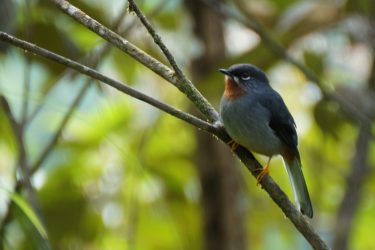In this series of blogs, Ed Drewitt freelance naturalist, broadcaster and wildlife detective highlights a different St Lucia bird each week. In this edition the Grey Trembler
By: Ed Drewitt

Grey trembler, Credit: Ed Drewitt
My first recollection of a grey trembler was seeing one coming to Anse Chastanet’s Treehouse Restaurant at breakfast time looking to see if there was any tasty fruit to snatch. An endearing bird, the grey trembler was shuffling its wings as if nervous, although this is a normal part of its behaviour. Its bright yellow eye was piercing against its grey and black plumage and its bill, slightly downcurved unmistakable. I was hooked – this was definitely one of my favourite birds already. Since then I have observed it in more natural settings in the forest, searching for grubs and beetles amongst the leaf litter and under tree bark.
While visiting St Lucia, if you spot a bird shuffling or trembling its wings, it is sure to be a grey trembler. It is only found on the island of St Lucia and Martinique. In the absence of woodpeckers and woodcreepers, the grey trembler is ideally adapted for probing and pecking around dead wood, branches, bromeliads and foliage looking for insects, centipedes, spiders, fruit and even lizards. They prefer the wetter, mature forests on St Lucia where the damp woodland provides soft, rotting wood to probe for food, although can still be found in drier scrub and open woodland.

If you spot a bird shuffling or trembling its wings, it is sure to be a grey trembler, Credit: Ed Drewitt
Look for a starling-size bird, relatively short-tailed with a grey body, black mask leading from the beak to beyond the eyes, a long, slightly downcurved beak and a bright yellow eye. At nature reserves such as Millet you will see grey tremblers coming to feed on coconuts put out for them since Hurricane Tomas in 2010.
While its grey and black plumage keeps it hidden in the trees, the grey trembler has a rich song that travels across the forest. As it sings it quivers its wing and vibrates its tail. The song is used for establishing a territory during the nesting season and is melodious, sweet and varied. Listen here for recordings of their songs and calls. You may hear it singing throughout other parts of the year too, maintaining its territory from rival birds.

It is better that the trembler feeds on natural fruits and insects, Credit: Ed Drewitt
Although it is a woodland specialist, the grey trembler will visit hotels often looking out for food, such as fruit, left on tables and can be very approachable. It is better that the trembler feeds on natural fruits and insects, although its presence can offer the chance to see and photograph this bird which is often otherwise hidden in the trees. If you see two together see if you can work out their sex. Females are slightly smaller than males although their beak is 18% longer!
Grey tremblers are part of the family of birds that includes mockingbirds and thrashers, many of which prefer drier, more arid landscapes. The tremblers on Caribbean Island buck the trend by preferring moist, humid habitats such as rainforest found in the mountains of St Lucia.
Ed Drewitt is a freelance naturalist, broadcaster and wildlife detective
Learn More About Bird Watching at Anse Chastanet here


